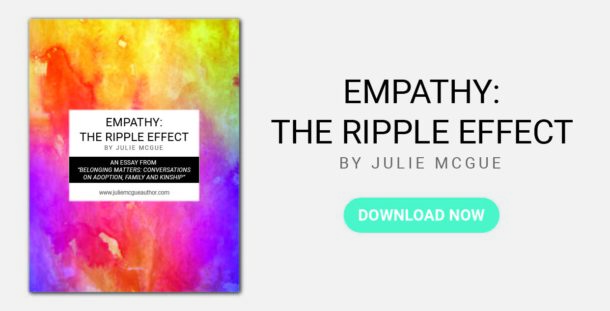What Is Genetic Genealogy And How Does It Help Me Find My Relatives?

Julie McGue
Author
Quite simply, genetic genealogy is the study of one’s family tree or genealogy.
Taking that one step further, genetic genealogy is the use of genealogical DNA tests, i.e. DNA profiling and DNA testing in combination with traditional genealogical methods, to infer biological relationships between individuals (source: Wikipedia). Genetic genealogy also means using advanced DNA testing to solve police cold cases.
Most of us have read about DNA testing and participated in it through sites like Ancestry.com or 23nMe. In previous blog posts (see “First Cousins” on 12/18/20), I shared how one of these sites introduced me to first cousins whom I eventually met up with in person. In another post (see “Quirky DNA Test Results” on 5/15/19), I discussed some odd results that popped up on my match profile because of being an identical twin.
In my memoir, Twice A Daughter, due out in May 2021 (SheWritesPress), I talk about how I tried to use genetic genealogy to link to my birth relatives in 2010 – an effort made more complicated by the fact that the number of subscribers at that time was not near what it is now. Proof that there is power in numbers. Fortunately, a traditionally trained genealogist did the archive legwork and unlocked my case.
Here’s a great post on genetic genealogy by a fellow adoptee, Lynn Grubb whose blog, No Apologies for Being Me , is worth following:
I was sharing the story of finding my birth father with the local DNA interest group I am part of and one of the members suggested I share it with the local genealogical society, so I wanted to write something coherent for not only them, but anyone who wants to understand the strategies that were used in finding my biological father, especially when a “case” does not fit the typical DNA strategy.
The lessons that follow are assuming that the adoptee has their DNA in all of the following already: Ancestry DNA, 23 and Me, Family Tree DNA, My Heritage and Gedmatch.
When I was first learning genetic genealogy, it was stressed to me that the goal was to find common ancestors amongst two or more DNA matches and then, that would lead one to conclude that if two DNA matches share the common ancestor, then you do to. Unfortunately, that strategy never worked for me because I have a father who was a very recent immigrant. For years, I never had anything closer than a 4th cousin match with bad trees. It took seven years doing genetic genealogy for me to get one second cousin match. This is highly unusual when there are people getting close matches all the time.
As I have said in past discussions on this topic, the first thing you should do when helping an adoptee locate a parent is attempt to order the original birth certificate and the non-identifying information from the adoption agency or court of adoption. Keep in mind that these documents can be false. Here are some examples of how they can be false:
*birth mothers sometimes (it’s rare) used aliases on birth certificates (sometimes part of the name is true but the other part is false).
*birth mothers name wrong fathers (common).
*agencies and mothers created story lines about relationships with fathers, especially when the fathers were married or there was a family scandal of some sort
What this means is not to get too focused in on the story line that the paper trail is presenting. Some of it is likely true; however, you may have no way of knowing which part until later, as the pieces come together. The majority of the information in the non-ID related to my father was false and my search team spent many years going down rabbit trails.
Second, pay close attention to surnames. The strategy my search team used was typing surnames in the “Notes” section of my Ancestry DNA. I also kept a spreadsheet of my DNA matches along with their surnames and ancestor locations. Get to know the surnames well. That way, when you see a surname again in another DNA match, your brain goes, “A-HA!”. My father’s surname was in my DNA early on and I paid attention to it, but I had nothing else to tie it to because it was not a close match.
Much later, when I got my second cousin match with that same surname, and a month later a third cousin with that same surname, I took note immediately. Keep in mind I have never connected common ancestors within the trees of these DNA matches because many Peruvian records are either not indexed or otherwise unavailable. Trees of my DNA matches at all DNA sites are sketchy at best and nonexistent at worst, so as you can imagine, the team spent hours and hours building trees.
I still have no birth record for my father and was only able to tie him to my second cousin match by asking a cousin for help. It turned out my second cousin match was a ½ first cousin. My match shared a grandfather with me but not a grandmother. Just using records, I may not have been able to figure that out, had I not reached out to a family member.
If you are dealing with a recent immigrant, I have found 23 and Me to be the most accurate ethnicity result, at least for me. 23 pinpointed the exact location my birth father was from in Peru. I knew I was Peruvian approximately two years before I found my actual birth father, thanks to 23 and Me. This was determined without any close matches in the database. The town my birth father was from was listed as No. 1.
I cannot stress this enough: YEARBOOKS ARE YOUR FRIEND. Ancestry has recently uploaded more and more yearbooks. Keep checking as more are added. Ultimately, because I had no common ancestors amongst my Peruvian DNA matches, I used surname searches within Ancestry yearbooks in the area of my conception (calculate your estimated conception date using your birth date). If you don’t know where you were conceived, use your birth/adoption location. A college yearbook in the location of my conception/birth/adoption using a unique surname in my second matches’ tree is what ultimately led to the discovery of my biological father.
“Fortunately, a traditionally trained genealogist did the archive legwork and unlocked my case.”

Snag my in-depth reference guide to best equip you for the journey ahead.



0 Comments